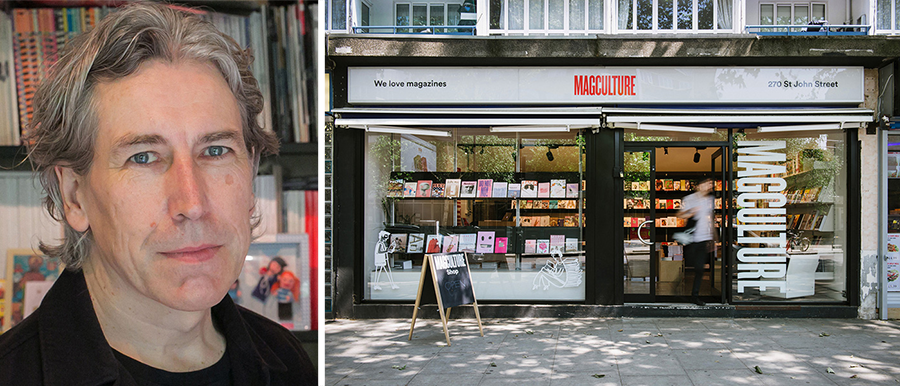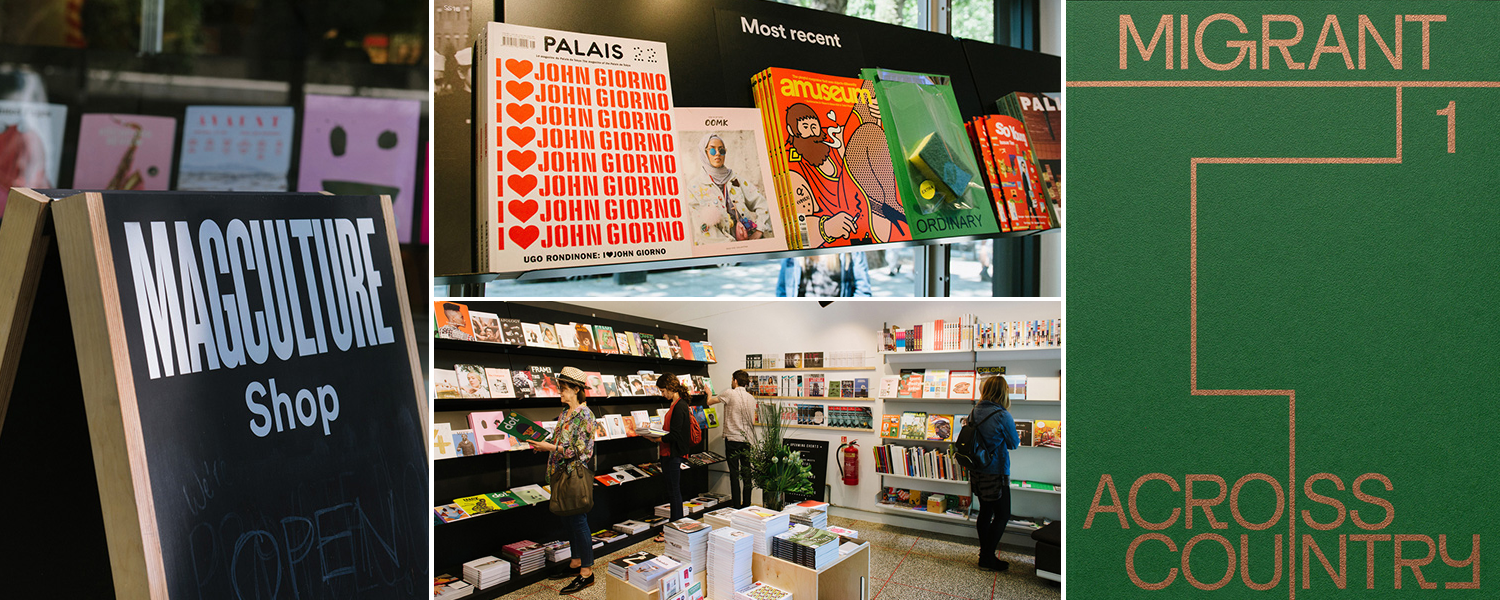
Jeremy Leslie, left, Mag Culture storefront, right
Massimo Pitis, director of Pitis brand identity and editorial design consultancy, chats with Jeremy Leslie of Mag Culture about magazines and the never-ending story of printed matter.
Massimo Pitis: Let's start from The End Of Print. Twenty one years ago, David Carson published his book after spearheading a revolution in print magazines. In one gesture, he was both renewing the printed artefact and burying it. Is it now time for a resurrection?
Jeremy Leslie: Print never died, and I don’t believe that was what Carson was predicting. His slogan was more of a challenge to the status quo, but was picked up by others and used in a more literal sense.
Thirteen years ago I published my book magCulture, in which I was arguing against the idea that print was dying. Print was and is changing, just as it always has been. As a delivery system, it has both benefited and suffered from societal and technological changes ever since a piece of print was first christened a "magazine" (in 1731, by the way).
In my book, I noted a new generation of small magazines that were appearing; they share a lineage with the pop ‘zines of the 50s, the alternative culture mags of the 60s, the political mags of the 70s and the pop culture indies of the 80s. The desire to create a discrete collection of printed content remains a powerful drive for every generation.
Digital evangelists drove the "print is dead" message further but in a beautiful irony the internet has empowered magazine makers. It is easier than ever to produce a magazine thanks to the computers on our desks, and simpler to market and sell across the world. (It is very different for newspapers of course but that’s a different story).
I’ve also noticed a change among design students and graduates. Ten years ago they only wanted to design websites. Today they regard the web as vital but unremarkable, they have their tumblrs, blogs, social media, apps, et cetera and take it all for granted. The more exciting thing for them is to design something in print.
MP: Why do printed magazines still represent a fundamental space for advertising investment?
JL: I’m not certain they do! The migration of advertising dollars to digital has been a major issue for printed magazines, breaking the traditional business model. The exception remains high end fashion and luxury goods. These brands don’t trust digital and prefer to be seen in print, but this will change too.
I believe we’re seeing a fantastically creative time in magazine publishing as people try lots of news ideas and experiments. In a sense, there is nothing to lose—twenty years ago publishers were making serious profits and weren’t prepared to risk them.

Left and center, images from Mag Culture in London. Right, cover of Migrant's Journal.
MP: What, in your opinion is the best designed magazine in EU? And in the US?
JL: Thoughts always shift around this; today will be one thing tomorrow another. Right now my favourite European magazine is MacGuffin, a magazine that uses everyday items to investigate how design affects society and people. It’s a beautifully conceived and designed small independent magazine from the Netherlands.
The US has plenty to be proud of in magazine design, but right now I’d have to point to The New York Times Magazine as the epitome of all that is great about US publishing: superbly crafted content, strong art direction and brilliant design. Gail Bichler and her team make it look effortless, when of course it is really relentless work, week in, week out.
MP: Which magazine is presenting the most interesting ideas today?
JL: A healthy idea is to publish only a limited number of issues—that is launching with the intention of producing only six, 10, or 20 issues. Migrant Journal is one magazine that has recently announced this. As its name suggests, it is dealing with the broad issue of migration, but will make only six themed issues over the next few years.
MP: What is the craziest magazine that you have in your shop?
JL: Right now the craziest magazine is Ordinary, also from the Netherlands. Each of the four issues to date has had an object mounted on the cover (a set of plastic cutlery, a dishwasher sponge, cotton buds, a pair of socks) and the inside has featured photographs of the object creatively deployed by various artists. Of course the reader is encouraged to take the object and create their own interpretation of it.
MP: Do you collect old magazines? Which is your favorite one?
JL: I have a small collection of old magazines, of which my favorite is, I think, a series of Sunday Times Magazines from 1969, reporting on the first moon landings. I vividly remember seeing that all happen at the time, and that particular magazine was an unconscious influence on me as I grew up.
More essential to me is the ever-growing contemporary collection I’m forming. I’ve just done a take over of the ZEITmagazin Instagram feed and presented a series of early indies, current insides, and brand new indies for the future. It’s made me realize that magazines are more than a set of individual runs of issues; they are all linked together and cross-influencing. They are a continuum—even as one magazine might close and another opens, this is not happening in isolation.
MP: At Mag Culture you have an incredible selection of magazines and it's a clear snapshot of the times. What's the vision of Mag Culture tomorrow? What direction do you foresee for the market in the coming years?
JL: Magazines have always been a reflection of their times, and on occasion even led their times. Right now I’m seeing a shift away from the bookish perfect bound "object" magazine toward more accessible, simpler formats. And I’m anticipating a move towards the more overtly political as we see the world get coarser and more illiberal.
Special thanks to Evie Gurney.
